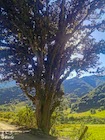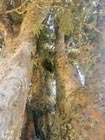Conservation Status

Pectinopitys exigua
(de Laub.) C.N.Page 2019
Common names
Pino colorado, pino negro [Spanish] (Farjon 2010).
Taxonomic notes
Type: Bolivia, Cochabamba, road from Sihuenca to Totora, M. Cardenas 4879 (holo US). An image of the holotype, collected 1951, can be seen here (accessed 2023.02.27; Smithsonian type specimen collection). Syn. Prumnopitys exigua De Laub. 1984. Page (2019, p. 148) assigns this species to Pectinopitys rather than Prumnopitys on the basis of evidence observable on herbarium collections; field characters are not discussed and it appears no molecular work has yet been performed.
Description
Trees to 20 m tall and 100 cm dbh, with a short stout bole and spreading branches forming a rounded crown. Bark first smooth, later exfoliating in irregular papery strips; reddish brown, weathering darker. Leaves alternate, petiolate, twisted at base, mostly pectinate in 2 rows, linear, slightly curved above base, widest above middle, with adaxial (upper) and abaxial (lower) midribs; margin entire; apex obtuse; size 10-20 × 2.2-3.1 mm in mature trees, more slender (ca. 1.8-2.3 mm wide) in seedlings and saplings; color yellow-green at flush, turning lustrous dark green above and dull light green below; stomata in 2 bands of numerous lines on either side of abaxial midrib. Pollen cones on lateral and axillary spikes near branch tips, each spike bearing up to 20 spreading cones, each axillary to a small leaf, 7-10 × 2 mm. Seed cones solitary on 10-15 mm long twigs, green ripening yellow, consisting of an epimatium covering a globose seed that at maturity is pruinose, 10-12 mm diameter, with an apical crest (Farjon 2010).
Distribution and Ecology
Bolivia: the Departments of Cochabamba (Province: Carrasco), Chuquisaca (Province: Belisario Boeto) and Santa Cruz (Province: Florida and Vallegrande). It grows at elevations of 1850-3000 m in upper montane evergreen rainforests rich in epiphytes; near the upper elevation limits, it occurs as a small tree in cloud forest. This habitat is similar to that of Prumnopitys montana but the two species occur in areas 1000 km apart (Farjon 2010, Zenito et al. 2013). An example of the cloud forest habitat is provided by Bosque Yungas in Parque Nacional Carrasco (Cochabamba) and Bosque Tucumano Boliviano (Chuquisaca and Santa Cruz), where it occurs at 2700-3000 m elevation. Here, the primary associated trees include Persea ruizii and Podocarpus glomeratus. Other associated trees include Alnus acuminata, Blepharocalyx salicifolius, Cedrela lilloi, Ilex argentina, Juglans boliviana, Myrcianthes callicoma, Podocarpus parlatorei, Podocarpus rusbyi, Ternstremia asymmetrica and Weinmannia microphylla (Zenito et al. 2013).
The IUCN classifies this species as "Near Threatened." The extent of occurrence is substantial at ca. 25,500 km2. The habitat has been severely fragmented by habitat degradation (mainly due to logging and slash-and-burn agriculture) and habitat loss (mainly conversion to agriculture and grazing lands). Although the species does occur in one protected area, the contiguous Parque Nacional Amboró and Parque Nacional Carrasco, still the trends of habitat loss and fragmentation are likely to continue (Zenito et al. 2013). A 2023 literature review found no documentation of further conservation actions to benefit this species, so, given the age of the IUCN assessment, the species likely qualifies as "Vulnerable" by now.
Remarkable Specimens
No data as of 2023.02.21.
Ethnobotany
The wood is valued for construction and carpentry, but is of local significance; exploitation through logging does not target this species, and it is taken along with more abundant and commercially significant podocarps. Trees in cloud forest habitat are too stunted to be of commercial value. The species is not in cultivation (Farjon 2010).
Observations
There are 61 georeferenced observations tabulated at GBIF (accessed 2023.02.27).
Remarks
The epithet is from the Latin exiguus, "short"; it was at first thought to be a dwarfed plant, but larger specimens were later identified.
Citations
Page, Christopher N. 2019. New and Maintained Genera in the Taxonomic Alliance of Prumnopitys s.l. (Podocarpaceae), and Circumscription of a New Genus: Pectinopitys. New Zealand Journal of Botany 57(3):137–53. https://doi.org/10.1080/0028825X.2019.1625933.
Zenito, F., D. Alanes, E. Nieto Blazquez, and M. Gardner. 2013. Prumnopitys exigua. The IUCN Red List of Threatened Species 2013: e.T38323A2868444. https://dx.doi.org/10.2305/IUCN.UK.2013-1.RLTS.T38323A2868444.en, accessed 2023.02.27.
See also
The species page at POWO, accessed 2023.02.27.
The species account at Threatened Conifers of the World, which includes some good photographs.




